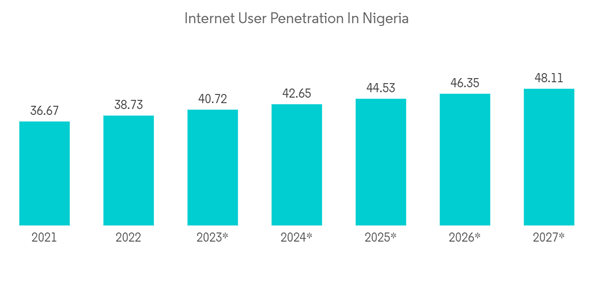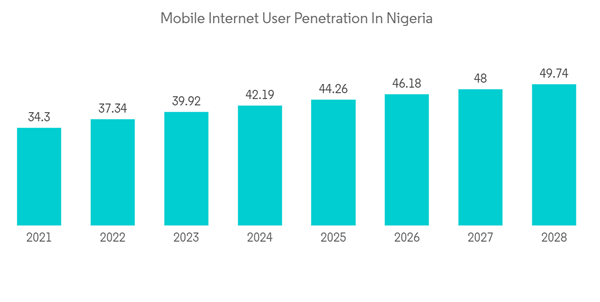Under Construction IT Load Capacity: The upcoming IT load capacity of the Nigeria data center rack market is expected to reach 220 MW by 2029.
Under Construction Raised Floor Space: The country's construction of raised floor area is expected to increase to 0.6 million sq. ft by 2029.
Planned Racks: The country's total number of racks to be installed is expected to reach 32,000 units by 2029. Johannesburg is expected to house the maximum number of racks by 2029.
Planned Submarine Cables: There are close to eight submarine cable systems connecting Nigeria, and many are under construction.
Nigeria Data Center Rack Market Trends
Cloud segment to hold major share in the market
- The increasing adoption of cloud-based services is driving the expansion of retail and wholesale colocation services in Nigeria, resulting in increased demand for space in data centers and, consequently, the need for more racks within data centers.
- Cloud services are growing in popularity in Nigeria. The need for big data integration and the demand for more remote work and data migration to the cloud are driving the use of domestic cloud data centers.
- Additionally, Nigerian data center providers are gradually collaborating with local and international technology companies to offer a wide range of services to their customers. For example, Galaxy Backbone has completed the construction of approximately 2.2 petabytes of Tier 4 data centers to provide cloud and disaster recovery services.
- With the rise of the digital economy and increased internet usage in Nigeria, the need for data storage and processing has increased. The proliferation of hybrid cloud service providers has increased demand for colocation services and increased rack utilization.
- With the introduction of government initiatives such as the Cloud Computing Policy (2019), which aimed to promote the spread of cloud services in the country, the use of data centers to store large amounts of data has increased, and with it, the demand.
Full rack segment to hold major share in the market
- In Nigeria, full racks hold the majority of the market share due to the growing space shortage among various companies. Building a fully racked data center is necessary to cope with increasing rack capacity due to increased analytics combined with mobile broadband, e-commerce, and cloud computing.
- The introduction of electronic payments in Nigeria has encouraged payment service providers to enter the country, highlighting the country as a promising market. This encourages the use of data centers to store information and increases the use of data center racks.
- As businesses generate massive amounts of data every day, they are increasingly relying on data centers to efficiently manage their databases and storage. A major factor driving the use of data center racks, therefore, is the increasing use of fully configured data centers.
- In addition, market growth is influenced by rising demand for IT services and investment by large enterprises.
- The introduction of high-density applications by various end-users such as IT and telecommunications, media, and entertainment creates opportunities for increased use of full racks in data centers. Nigeria's online commerce and financial technology is powered by a rapidly growing youth population, increasing spending power, and smartphone penetration. These factors correspond to the increasing use of full racks in data centers.
Nigeria Data Center Rack Industry Overview
The Nigerian Data center racks market is relatively low in terms of competition and has a few players in the market, such as Vertiv Group Corp., Dell Inc., Eaton Corporation, Rittal GMBH & Co.KG, Schneider Electric SE, and nVent Electric PLC. These major players focus on expanding their customer base in the country. These companies leverage strategic collaborative initiatives to increase their market share and profitability. The increase in the data center construction corresponds to increasing demand for the number of racks in the data centers.In April 2023, Rack Centre is planning to build a 12MW data center in the Ikeja area of Lagos, Nigeria. The new facility will be known as the Rack Centre LGS 2 and will be situated on a 20,000 sqm (215,280 sq ft) greenfield site.
In December 2022, WIOCC launched a data center in Lagos through its Open Access Data Centres platform. The facility was planned to support up to 20MW of site load across more than 7,200 sqm (77,500 sq ft) of white space, enough for 3,200 racks, and can be scaled up to 40MW.
Additional Benefits:
- The market estimate (ME) sheet in Excel format
- 3 months of analyst support
This product will be delivered within 2 business days.










